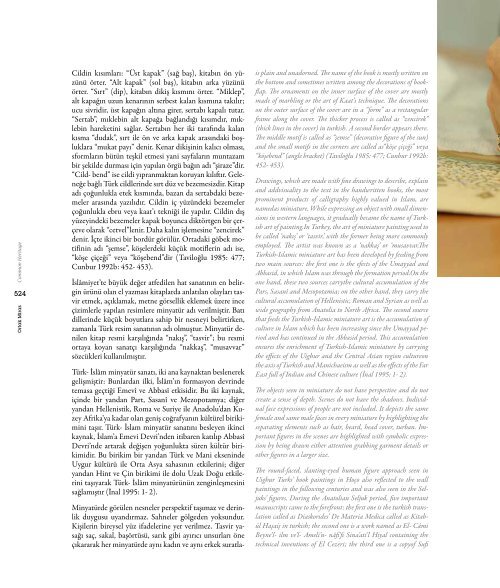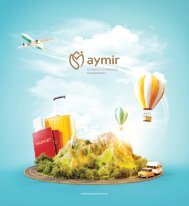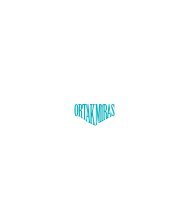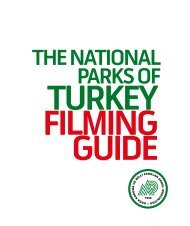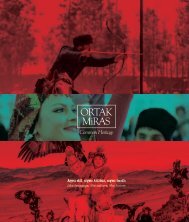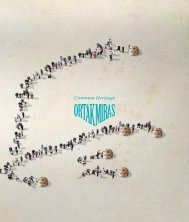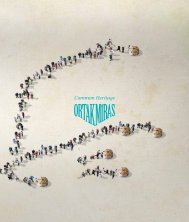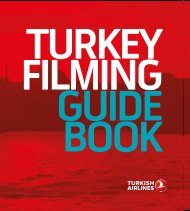Create successful ePaper yourself
Turn your PDF publications into a flip-book with our unique Google optimized e-Paper software.
Common Heritage<br />
524<br />
Ortak Miras<br />
Cildin kısımları: “Üst kapak” (sağ baş), kitabın ön yüzünü<br />
örter. “Alt kapak” (sol baş), kitabın arka yüzünü<br />
örter. “Sırt” (dip), kitabın dikiş kısmını örter. “Miklep”,<br />
alt kapağın uzun kenarının serbest kalan kısmına takılır;<br />
ucu sivridir, üst kapağın altına girer, sertabı kapalı tutar.<br />
“Sertab”, mıklebin alt kapağa bağlandığı kısımdır, mıklebin<br />
hareketini sağlar. Sertabın her iki tarafında kalan<br />
kısma “dudak”, sırt ile ön ve arka kapak arasındaki boşluklara<br />
“mukat payı” denir. Kenar dikişinin kalıcı olması,<br />
sformların bütün teşkil etmesi yani sayfaların muntazam<br />
bir şekilde durması için yapılan örgü bağın adı “şiraze”dir.<br />
“Cild- bend” ise cildi yıpranmaktan koruyan kılıftır. Geleneğe<br />
bağlı Türk cildlerinde sırt düz ve bezemesizdir. Kitap<br />
adı çoğunlukla etek kısmında, bazan da sertabdaki bezemeler<br />
arasında yazılıdır. Cildin iç yüzündeki bezemeler<br />
çoğunlukla ebru veya kaat’ı tekniği ile yapılır. Cildin dış<br />
yüzeyindeki bezemeler kapak boyunca diktörtgen bir çerçeve<br />
olarak “cetvel”lenir. Daha kalın işlemesine “zencirek”<br />
denir. İçte ikinci bir bordür görülür. Ortadaki göbek motifinin<br />
adı “şemse”, köşelerdeki küçük motiflerin adı ise,<br />
“köşe çiçeği” veya “köşebend”dir (Taviloğlu 1985: 477;<br />
Cunbur 1992b: 452- 453).<br />
İslâmiyet’te büyük değer atfedilen hat sanatının en belirgin<br />
ürünü olan el yazması kitaplarda anlatılan olayları tasvir<br />
etmek, açıklamak, metne görsellik eklemek üzere ince<br />
çizimlerle yapılan resimlere minyatür adı verilmiştir. Batı<br />
dillerinde küçük boyutlara sahip bir nesneyi belirtirken,<br />
zamanla Türk resim sanatının adı olmuştur. Minyatür denilen<br />
kitap resmi karşılığında “nakış”, “tasvir”; bu resmi<br />
ortaya koyan sanatçı karşılığında “nakkaş”, “musavvar”<br />
sözcükleri kullanılmıştır.<br />
Türk- İslâm minyatür sanatı, iki ana kaynaktan beslenerek<br />
gelişmiştir: Bunlardan ilki, İslâm’ın formasyon devrinde<br />
temasa geçtiği Emevî ve Abbasî etkisidir. Bu iki kaynak,<br />
içinde bir yandan Part, Sasanî ve Mezopotamya; diğer<br />
yandan Hellenistik, Roma ve Suriye ile Anadolu’dan Kuzey<br />
Afrika’ya kadar olan geniş coğrafyanın kültürel birikimini<br />
taşır. Türk- İslam minyatür sanatını besleyen ikinci<br />
kaynak, İslam’a Emevi Devri’nden itibaren katılıp Abbasî<br />
Devri’nde artarak değişen yoğunlukta süren kültür birikimidir.<br />
Bu birikim bir yandan Türk ve Mani ekseninde<br />
Uygur kültürü ile Orta Asya sahasının etkilerini; diğer<br />
yandan Hint ve Çin birikimi ile dolu Uzak Doğu etkilerini<br />
taşıyarak Türk- İslâm minyatürünün zenginleşmesini<br />
sağlamıştır (İnal 1995: 1- 2).<br />
Minyatürde görülen nesneler perspektif taşımaz ve derinlik<br />
duygusu uyandırmaz. Sahneler gölgeden yoksundur.<br />
Kişilerin bireysel yüz ifadelerine yer verilmez. Tasvir yasağı<br />
saç, sakal, başörtüsü, sarık gibi ayırıcı unsurları öne<br />
çıkararak her minyatürde aynı kadın ve aynı erkek suratlais<br />
plain and unadorned. The name of the book is mostly written on<br />
the bottom and sometimes written among the decorations of bookflap.<br />
The ornaments on the inner surface of the cover are mostly<br />
made of marbling or the art of Kaat’ı technique. The decorations<br />
on the outer surface of the cover are in a “form” as a rectangular<br />
frame along the cover. The thicker process is called as “zencirek”<br />
(thick lines in the cover) in turkish. A second border appears there.<br />
The middle motif is called as “şemse” (decorative figure of the sun)<br />
and the small motifs in the corners are called as“köşe çiçeği” veya<br />
“köşebend” (angle bracket) (Taviloğlu 1985: 477; Cunbur 1992b:<br />
452- 453).<br />
Drawings, which are made with fine drawings to describe, explain<br />
and addvisuality to the text in the handwritten books, the most<br />
prominent products of calligraphy highly valued in Islam, are<br />
namedas miniature. While expressing an object with small dimensions<br />
in western languages, it gradually became the name of Turkish<br />
art of painting.In Turkey, the art of miniature painting used to<br />
be called ‘nakış’ or ‘tasvir,’ with the former being more commonly<br />
employed. The artist was known as a ‘nakkaş’ or ‘musavvar.The<br />
Turkish-Islamic miniature art has been developed by feeding from<br />
two main sources: the first one is the efects of the Umayyad and<br />
Abbasid, in which Islam was through the formation period.On the<br />
one hand, these two sources carrythe cultural accumulation of the<br />
Pars, Sasanî and Mesopotamia; on the other hand, they carry the<br />
cultural accumulation of Hellenistic, Roman and Syrian as well as<br />
wide geography from Anatolia to North Africa. The second source<br />
that feeds the Turkish-Islamic miniature art is the accumulation of<br />
culture in Islam which has been increasing since the Umayyad period<br />
and has continued in the Abbasid period. This accumulation<br />
ensures the enrichment of Turkish-Islamic miniature by carrying<br />
the effects of the Uighur and the Central Asian region cultureon<br />
the axis of Turkish and Manichaeism as well as the effects of the Far<br />
East full of Indian and Chinese culture (İnal 1995: 1- 2).<br />
The objects seen in miniature do not have perspective and do not<br />
create a sense of depth. Scenes do not have the shadows. Individual<br />
face expressions of people are not included. It depicts the same<br />
female and same male faces in every miniature by highlighting the<br />
separating elements such as hair, beard, head cover, turban. Important<br />
figures in the scenes are highlighted with symbolic expression<br />
by being drawn either attention grabbing garment details or<br />
other figures in a larger size.<br />
The round-faced, slanting-eyed human figure approach seen in<br />
Uighur Turks’ book paintings in Hoço also reflected to the wall<br />
paintings in the following centuries and was also seen in the Seljuks’<br />
figures. During the Anatolian Seljuk period, five important<br />
manuscripts came to the forefront: the first one is the turkish translation<br />
called as Diaskorides’ De Materia Medica called as Kitabül<br />
Haşaiş in turkish; the second one is a work named as El- Câmi<br />
Beyne’l- ilm ve’l- Ameli’n- nâfi’fi Sina’ati’l Hiyal containing the<br />
technical inventions of El Cezeri; the third one is a copyof Sufi


